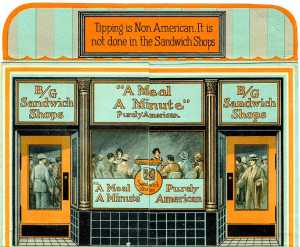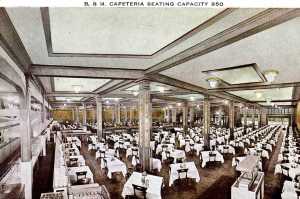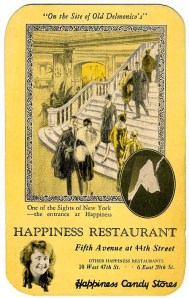 The 1920s is an important decade because it marked the birth of the modern restaurant industry. The advent of national prohibition stripped away liquor profits, shifting emphasis to low-price, high-volume food service. More people ate out than ever before. Restaurant owners formed professional associations to raise industry standards, counter organized labor, and lobby for their interests. Famous pre-war restaurants closed, while cafeterias, luncheonettes, and tea rooms thrived. Female servers began to replace men. Restaurant chains incorporated and were listed on the stock exchange. While critics bemoaned the demise of fine dining, the newborn industry and its patrons celebrated simple, home-style, “American” fare.
The 1920s is an important decade because it marked the birth of the modern restaurant industry. The advent of national prohibition stripped away liquor profits, shifting emphasis to low-price, high-volume food service. More people ate out than ever before. Restaurant owners formed professional associations to raise industry standards, counter organized labor, and lobby for their interests. Famous pre-war restaurants closed, while cafeterias, luncheonettes, and tea rooms thrived. Female servers began to replace men. Restaurant chains incorporated and were listed on the stock exchange. While critics bemoaned the demise of fine dining, the newborn industry and its patrons celebrated simple, home-style, “American” fare.
Highlights
 1920 After a strike of 1,100 cooks and waiters in Chicago, the Congress Hotel hires a crew of waitresses. – Milwaukee restaurateurs report that Sunday has become their biggest day because of families eating out.
1920 After a strike of 1,100 cooks and waiters in Chicago, the Congress Hotel hires a crew of waitresses. – Milwaukee restaurateurs report that Sunday has become their biggest day because of families eating out.
1921 A character in Alexander Black’s novel The Seventh Angel observes, “Life is just one damned restaurant after another,” then asks plaintively, “Is there any home-eating any more?” – A restaurant trade magazine reports that half of all restaurant meals in Los Angeles are sold in cafeterias and other self-service eateries. – In New York City, a former “lobster palace,” Murray’s Roman Gardens, advertises sodas and candy in its Ice Cream Salon.
1922 The International Association of Hotel Stewards endorses the elimination of French terms on menus.
1924 A brochure from the B/G Sandwich Shop chain boasts of “Food selected and prepared as in your American home; served by the sort of people you find at home, – high class ambitious young Americans who do not desire to submit to the European custom of depending upon the master’s gratuities.” – Cafeteria chain manager Harry Boos, president of the National Restaurant Association, declares: “Men and women want their goods quick and clean. The restaurant business is a greater industry than ever before in history.” – “Quick and Clean” is also the slogan of the White Cafeteria in Indianapolis.
 1925 After the closure of his once-celebrated NYC nightspot restaurant “Jack’s,” owner John Dunstan complains “The town’s full of cafeterias.” – Henri Mouquin’s famed French restaurant is demolished to make room for a Princeton Cafeteria.
1925 After the closure of his once-celebrated NYC nightspot restaurant “Jack’s,” owner John Dunstan complains “The town’s full of cafeterias.” – Henri Mouquin’s famed French restaurant is demolished to make room for a Princeton Cafeteria.
1926 The Cordleyware Co. advertises that its champagne buckets for restaurants can be used as carriers for soiled silverware.
1927 The journal Restaurant Management reports that from 25% to 30% of all meals in cities are eaten in restaurants and that close to 60% of restaurant patrons are women. – A restaurant of the Happiness Candy Stores chain opens on the Fifth Avenue site once occupied by Delmonico’s.
 1928 In recognition of the growing number of women in the restaurant business, the American Restaurant journal begins a special section called “The Restaurant Woman.” – Chicago’s corned beef sandwich mogul, John P. Harding, known for catering exclusively to men, opens a restaurant especially for women.
1928 In recognition of the growing number of women in the restaurant business, the American Restaurant journal begins a special section called “The Restaurant Woman.” – Chicago’s corned beef sandwich mogul, John P. Harding, known for catering exclusively to men, opens a restaurant especially for women.
1929 A restaurant trade magazine editorial asserts that the industry has finally won respectability. There is, it notes, “tremendous change in popular feeling toward a business once thought precarious – as well as beneath consideration, socially.”
Read about other decades: 1800 to 1810; 1810 to 1820; 1820 to 1830; 1860 to 1870; 1890 to 1900; 1900 to 1910; 1930 to 1940; 1940 to 1950; 1950 to 1960; 1960 to 1970; 1970 to 1980
© Jan Whitaker, 2008












 It's great to hear from readers and I take time to answer queries. I can't always find what you are looking for, but I do appreciate getting thank yous no matter what the outcome.
It's great to hear from readers and I take time to answer queries. I can't always find what you are looking for, but I do appreciate getting thank yous no matter what the outcome.



This site is great!
Nice site. Do you know the Old France Restaurant on Huntington Ave in Boston, fl. abt 1932?
Childs Old France was a restaurant and nightclub in business as early as 1928, maybe earlier. It closed in the early 1950s. It was across the street from the Symphony, at 258 Huntington, in a building later occupied by Junior Achievement.
I’m not sure it’s appropriate for this list, but in 1921 White Castle was founded in Wichita, KS. White Castle is often cited as America’s first fast food chain. It’s still family-owned and doesn’t franchise.
Thanks! This helped me a lot with my humanities project!
Pingback: Monday MMM… | Flapper Femme: what's Past is Prologue...
Pingback: Restaurants in 1920s
Pingback: Popularity of Restaurants Grows | The Gatsby Gazette
I just came across around 30 magazines dated in the early 1930’s called Restaurant Management and Hotel Management. I would like to know the value of them. (they are very retro) Anyone possibly know?
If you send me a list of their dates and condition, I will make you an offer. Write to me at janwhitaker@verizon.net
I don’t suppose you could tell us the average wages of chefs and waiters during this time?
It would take a great deal of research to answer this question with any degree of accuracy. But I think it was not uncommon for waiters to make $5 to $15 a week in wages, and maybe a couple of dollars a day in tips. According to a 1922 NY state survey waiters who were paid a 10% service charge on each bill often made $12 a week in wages and an average of $25 in tips. and Of course it all depends on whether they were unionized and what type of restaurant they worked at, which could be anything from a fine hotel to a cheap lunchroom. Again, the best paid chefs would be in hotels at this time, possibly making up to $4,000 a year.
I need a list of foods that would be served in a restaurant during the 1920s!
Thanks this helped me out on my roaring 20s project for school about food.:)
Same here.
hey it helped me with the same project on the twenties well i do good thanks
Thanks, This helped out alot for my 1920’s Essay!
thanks, your site is awesome and very helpful
thanks for this site! it really helped me with my roaring twenties pr0ject for school! 🙂
Same megz!!!!!!!!!!!!!!!!
Great! This info helped me with my Culture class.
Thanks